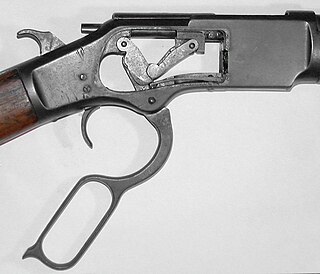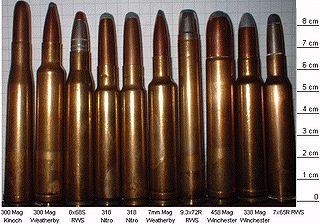Related Research Articles

In firearm designs, the term single-shot refers to guns that can hold only a single round of ammunition inside and thus must be reloaded manually after every shot. Compared to multi-shot repeating firearms ("repeaters"), single-shot designs have no moving parts other than the trigger, hammer/firing pin or frizzen, and therefore do not need a sizable receiver behind the barrel to accommodate a moving action, making them far less complex and more robust than revolvers or magazine/belt-fed firearms, but also with much slower rates of fire.
Winchester rifle is a comprehensive term describing a series of lever action repeating rifles manufactured by the Winchester Repeating Arms Company. Developed from the 1860 Henry rifle, Winchester rifles were among the earliest repeaters. The Model 1873 was particularly successful, being marketed by the manufacturer as "The Gun That Won the West".

The Colt Single Action Army is a single-action revolver handgun. It was designed for the U.S. government service revolver trials of 1872 by Colt's Patent Firearms Manufacturing Company and was adopted as the standard-issued pistol of the U.S. Army from 1873 until 1892.

Lever action is a type of action for repeating firearms that uses a manually operated cocking handle located around the trigger guard area that pivots forward to move the bolt via internal linkages, which will feed and extract cartridges into and out of the chamber, and cock the firing pin mechanism. This contrasts to other type of repeating actions such as the bolt action, pump action, semi-automatic, or automatic/selective-fire actions. A firearm using this operating mechanism is colloquially referred to as a levergun.

The .44-40 Winchester, also known as .44 Winchester, .44 WCF, and .44 Largo was introduced in 1873 by the Winchester Repeating Arms Company. It was the first metallic centerfire cartridge manufactured by Winchester, and was promoted as the standard chambering for the new Winchester Model 1873 rifle. As both a rifle and a handgun caliber, the cartridge soon became widely popular, so much so that the Winchester Model 1873 rifle became known as "The gun that won the West."
The Winchester Repeating Arms Company was a prominent American manufacturer of repeating firearms and ammunition. The firm was established in 1866 by Oliver Winchester and was located in New Haven, Connecticut. The firm went into receivership in 1931 and was bought by the Western Cartridge Company, a forerunner of the Olin Corporation. The Winchester brand name is still owned by the Olin Corporation, which makes ammunition under that name. The Winchester name is also used under license for firearms produced by two subsidiaries of the Herstal Group – FN Herstal of Belgium and the Browning Arms Company of Ogden, Utah.
The Winchester Model 70 is a bolt-action sporting rifle. It has an iconic place in American sporting culture and has been held in high regard by shooters since it was introduced in 1936, earning the moniker "The Rifleman's Rifle". The action has some design similarities to Mauser designs and it is a development of the earlier Winchester Model 54, itself based on a Mauser 98-type action.
The Winchester Model 1887 and Winchester Model 1901 are lever-action shotguns originally designed by famed American gun designer John Browning and produced by the Winchester Repeating Arms Company during the late 19th and early 20th centuries. The shotgun has become iconic for its use in the 1991 film Terminator 2: Judgment Day.
Marlin Firearms Co. is an American manufacturer of semi-automatic, lever-action, and bolt-action rifles. In the past, the company, now based in Madison, North Carolina, and formerly based in North Haven, Connecticut, made shotguns, derringers, and revolvers. Marlin owned the firearm manufacturer H&R Firearms. In 2007, Remington Arms, part of the Remington Outdoor Company, acquired Marlin Firearms. Remington produced Marlin-brand firearms at its Kentucky and New York manufacturing facilities. In 2020, Sturm, Ruger & Co. bought the company from bankrupt Remington Outdoor Company.

The .458 Winchester Magnum is a belted, straight-taper cased, Big Five game rifle cartridge. It was introduced commercially in 1956 by Winchester and first chambered in the Winchester Model 70 African rifle. It was designed to compete against the .450 Nitro Express and the .470 Nitro Express cartridges used in big bore British double rifles. The .458 Winchester Magnum remains one of the most popular large game cartridges, and most major ammunition manufacturers offer a selection of .458 ammunition.

H&R 1871, LLC, or more commonly known as Harrington & Richardson, is an American brand of firearms and a subsidiary of JJE Capital Holdings. H&R ceased independent production February 27, 2015.

Daisy Outdoor Products is an American airgun manufacturer known particularly for their lines of BB guns. It was formed in 1882 initially as the Plymouth Iron Windmill Company in Plymouth, Michigan, to manufacture steel windmills, and from 1888 started bundling BB-caliber air guns with each windmill purchase as a sales promotion. With the unrivaled popularity of their 1888-model Daisy BB Guns, the company changed the name to Daisy Manufacturing Company in 1895 and switched their business to solely producing air guns for sale. Throughout the 20th century, Daisy has been known as a company that makes and sells BB guns and pellet youth rifles. Their Red Ryder BB Gun is perhaps the best known and longest production item, which has been featured in many TV shows and movies since its introduction in the spring of 1940.
The Winchester Model 1894 rifle is a lever-action repeating rifle that became one of the most famous and popular hunting rifles of all time. It was designed by John Browning in 1894 and originally chambered to fire two metallic black powder cartridges, the .32-40 Winchester and .38-55 Winchester. It was the first rifle to chamber the smokeless powder round, the .30 WCF in 1895. In 1901, Winchester created the new .32 Winchester Special caliber with production of rifles starting in 1902.
The Remington Model 597 is an American semi-automatic rifle that was manufactured by Remington Arms at the company's Mayfield, Kentucky and Huntsville, Alabama plant. The .22 Long Rifle version has a removable 10-round magazine, while the magazines for the larger .22 WMR and .17 HMR cartridges hold eight rounds.

The Winchester Model 1892 was a lever-action repeating rifle designed by John Browning as a smaller, lighter version of his large-frame Model 1886, and which replaced the Model 1873 as the company's lever-action for pistol-caliber rounds such as the .44-40.
The .405 Winchester is a centerfire rifle cartridge introduced in 1904 for the Winchester 1895 lever-action rifle. It remains to this day one of the most powerful rimmed cartridge designed specifically for lever-action rifles; the only modern lever action cartridges that exceed its performance are the .50 Alaskan, .450 Alaskan, .475 Turnbull, .348 Turnbull, and the .450 Marlin. The .405 was highly regarded by U.S. President Theodore Roosevelt during his safari in East Africa.

The Winchester Model 1907 is a blowback-operated, semi-automatic rifle produced by the Winchester Repeating Arms Company beginning in 1907 with production ending in 1957. It fired a cartridge of intermediate power, cycled through a semi-automatic operating mechanism, fed from a 5, 10, or 15 round detachable box magazine located immediately forward of the trigger guard. In size and handling, it is much like an M1 carbine, though the 1907 is heavier and fires a much harder hitting round.
The Winchester Model 1890 is a slide-action repeating rifle produced by the Winchester Repeating Arms Company in the late 19th and early 20th century.
The Winchester Hotchkiss was a bolt-action repeating rifle patented by Benjamin B. Hotchkiss in 1876 and produced by the Winchester Repeating Arms Company and Springfield Armory from 1878. The Hotchkiss, like most early bolt-actions, had a single rear locking lug integral with the bolt handle, but was unique in feeding multiple rounds from a tubular buttstock magazine similar to the Spencer rifle. The .45-70 Hotchkiss was acquired in limited numbers by the US Navy as the M1879, and by the US Army and several state militias as the M1883, making it the first center-fire bolt-action repeater to be adopted by any major military.
The Winchester Model 1903 was the first commercially available semi-automatic firearm made by the Winchester Repeating Arms Company.
References
- ↑ Henshaw, Thomas (1993). The History of Winchester Firearms 1866-1992. Academic Learning Company LLC. pp. 140–141. ISBN 0-8329-0503-8 . Retrieved March 23, 2011.
- ↑ "Model 100 Winchester recall questions".
